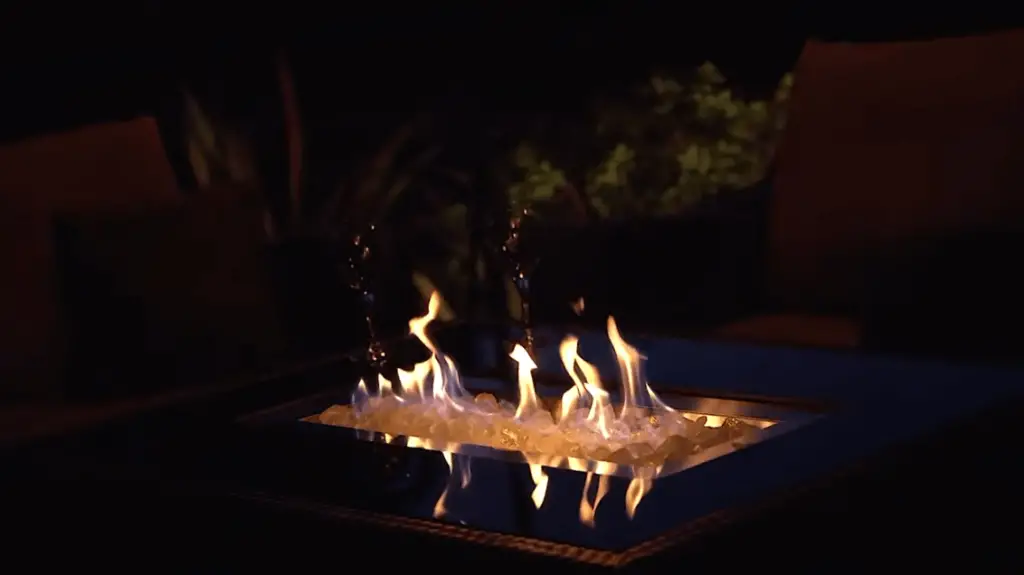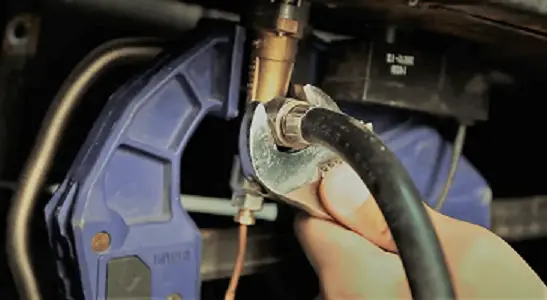Note: This article may contain affiliate links, which means if you make a purchase following our links won’t cost you extra, but we may earn a commission. Learn more
The fire pits are designed as one of the main considerations for their burning fuel type. Therefore, their capacity, characteristics, and type of ignition is different. However, the pressure of propane gas is high, so its price is also a bit higher and they burn fast. Natural gas, on the other hand, has the opposite characteristics.
So, although the functions of the two gases are the same, the type and level of work are different. That is not to say that one cannot do the work of another. They can, but they need to be provided with the right materials. How we’ll collect it, how we convert it, or whether we should do it is our subject of discussion.
Can Propane Fire Pits Use Natural Gas?
If you’re considering using a propane fire pit, you may be wondering if you can use natural gas instead. The answer is yes, you can use natural gas in a propane fire pit, but has some prosecutions. However, there are a few things to keep in mind.
First, propane fire pits are designed to use propane. Using natural gas in a propane fire pit can void the warranty.
Second, propane is more expensive than natural gas, so you’ll want to factor that into your decision.

Third, natural gas is less portable than propane. If you plan on using your fire pit at different locations, propane may be the better option.
Fourth, you’ll need to have a natural gas line installed if you don’t already have one. This can be a bit expensive and may not be possible depending on your location.
Finally, keep in mind that using natural gas in a propane fire pit is not without risks. If you’re not comfortable with these risks, propane may be the better option for you.
Why Do You Need to Convert a Propane Fire Pit to Natural Gas?
1. The cost of propane has been on the rise in recent years, while the cost of natural gas has remained relatively stable. This means that converting your propane fire pit to natural gas can save you money in the long run.
2. Natural gas is more environmentally friendly than propane. Natural gas is a cleaner-burning fuel than propane, It produces less carbon dioxide and other pollutants when burned. which means it produces fewer emissions. This is better for the environment and can also help to improve air quality.
3. Natural gas is more convenient than propane. Natural gas is a piped-in service, which means you’ll never have to worry about running out of fuel or refilling your tank. It is piped directly to your home, so you don’t have to worry about running out of propane. Propane tanks need to be refilled or replaced periodically, which can be a hassle.
4. Natural gas is more reliable than propane. Natural gas is a consistent, dependable fuel source. Propane can be affected by weather conditions, which can cause disruptions in service.
5. Natural gas is safer than propane. Natural gas is less flammable than propane, which makes it a safer option for your home. In the event of a leak, natural gas will dissipate quickly, while propane can linger in the air and pose a risk of explosion.
5. Natural gas fire pits provide consistent performance. They produce consistent heat and flames, so you can enjoy your fire pit for years to come.
What Are the Dangers of Converting Propane Fire Pits to Natural Gas?
As the popularity of backyard fire pits continues to grow, so does the popularity of converting them from propane to natural gas. While this may seem like a simple and easy process, there are a few dangers that you should be aware of before making the switch.
Leaks
One of the most common dangers of converting a propane fire pit to natural gas is leaks. If not done properly, gas can leak from the connection points and pose a serious fire and health hazard. Be sure to have a professional check for leaks before using your fire pit.
Explosion
Another danger with natural gas is the potential for explosion. If there is a leak in the gas line, the accumulation of gas could lead to an explosion. Be sure to have your fire pit professionally inspected for leaks and make sure there is proper ventilation.
Carbon Monoxide Poisoning
One of the dangers of using any type of combustion is the potential for carbon monoxide poisoning. This is especially true with fire pits because they are often used in enclosed spaces. Be sure to have your fire pit properly ventilated to avoid this danger.
Fires
One of the most common dangers of any type of fire is the potential for accidental fires. Make sure to consult with a professional to ensure your fire pit is properly ventilated before converting to natural gas.
Some Considerations Before Converting
If you’re considering converting your propane fire pit to natural gas, there are a few things you need to take into consideration. Here are 5 things to think about before making the switch:
1. Cost – Converting your fire pit from propane to natural gas may cost more upfront, but it could save you money in the long run. Natural gas is often cheaper than propane, so you’ll likely see savings on your fuel costs.
2. Availability – Not all areas have natural gas service, so you’ll need to make sure it’s available in your area before making the switch.
3. Permits – You may need to obtain a permit from your local municipality before converting your fire pit to natural gas.
4. Safety – Natural gas is flammable, so you’ll need to take extra precautions to ensure your fire pit is safe. Make sure to read all the instructions carefully before starting the conversion process.
What Are the Benefits of Converting a Propane Fire Pit to Natural Gas?
At one time, converting a propane fire pit to natural gas was a daunting and expensive task. But recent innovations have made the process much simpler and more affordable. Here are five things to consider when converting your propane fire pit to natural gas:
1. Cost: The initial cost of converting your propane fire pit to natural gas can be significant. But over time, natural gas will save you money. Propane is a volatile, fossil fuel that fluctuates in price. Natural gas is a cleaner, more stable fuel that is less expensive in the long run.
2. Convenience: Natural gas is a convenient fuel source. It is piped directly to your home, so you don’t have to worry about running out of propane.
3. Environment: Natural gas is a cleaner-burning fuel than propane. It produces less carbon dioxide and other pollutants when burned.
4. Safety: Natural gas is a safe, reliable fuel source. Unlike propane, it is not flammable when stored in its natural state.
5. Performance: Natural gas fire pits provide consistent performance. They produce consistent heat and flames, so you can enjoy your fire pit for years to come.
Read More: What to Put Under a Fire Pit/ on Grass? Why?
How to Convert Propane Fire Pit to Natural Gas?
Whether you’re looking to save money on fuel costs or you simply prefer the convenience of natural gas, the process of converting your fire pit is actually quite simple. In just a few easy steps, you can have your fire pit running on natural gas in no time.
If you want to convert your propane fire pit to natural gas, you’ll need to purchase a conversion kit. You can find these kits at most hardware stores or home improvement shops. Once you have the conversion kit, follow the instructions that come with it in order to properly install the new components.
The task is not too difficult. You can do this successfully by following a few steps.
Step-1: Turn Off the Gas to Your Fire Pit
Before you begin the conversion process, you’ll need to turn off the gas to your fire pit to disconnect the propane tank.
You’ll want to make sure that there is no propane left in the tank before you proceed. Turn off the gas to your fire pit and disconnect the hose. You will need to do this so that you can safely work on the fire pit.
Step-2: Disconnect the Propane Tank
The next step is to disconnect the propane tank. Use a pipe wrench to disconnect the gas regulator from the tank. Remove the burner and any other propane components from the fire pit. This includes the control knob, the regulator, and the hose.
Step-3: Install the Natural Gas Line

This step is to install the natural gas components that come with your conversion kit. This includes the new burner, the control knob, and the regulator. Insert the natural gas hose into the orifice. Install the natural gas components.
This is a relatively simple process. You’ll need to connect the gas line to the inlet on the fire pit. Once the gas line is connected, you can turn on the gas.
Step-4: Install the Natural Gas Line
you will need to connect the gas line from your home to the fire pit. Use the wrench to screw the natural gas hose into place. Tighten the connection with a pipe wrench.
Step-5: Test the Fire Pit
Once the gas line is connected, turn on the gas valve and light the fire pit according to the manufacturer’s instructions. Once you’ve installed the natural gas line, you’ll need to test the fire pit. Make sure that the gas is turned on and the light is a match.
Hold the match near the burner opening. If the pit ignites, you’ve successfully converted your fire pit. Turn on the gas and check for leaks. Make sure that everything is working correctly and that there are no leaks.
Step-6: Enjoy the Benefits
Now that you’ve successfully converted your fire pit, you can sit back and enjoy the benefits of a natural gas fire pit. These pits are more efficient than propane pits and they’re easy to use. You’ll be able to enjoy your fire pit for many years to come.
And that’s it! You’ve now successfully converted your propane fire pit to natural gas. Just remember to always follow the manufacturer’s instructions when working with gas lines and fire pits.